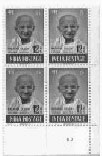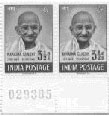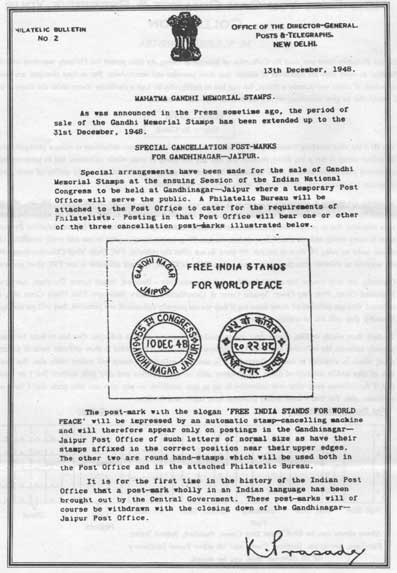
 |
The 15th August 1948, the 1st Anniversary of India's
Independence was commemorated by issuing postage stamps on "Mahatma
Gandhiji" in 4 denominations viz., 1½ as. 3½ as., 12as.
and 10 Rupees. The first 3 lower values are in Sepia-brown (Brown), Purple-
blue (Violet), Dark-green (Grey -green) respectively. The high value 10
Rupees stamp is in Grey with a Reddish-brown background (Purple-brown
and lake). All these stamps were printed in sheets of 50 in 5 rows of
10 stamps each with all around and perforated 11½ mm. The top margin
has a long inscription extending on 8 stamps, from 2nd to 9th reading
"IMRESSION COURVOISER S.A., LA CHAUX - DE - FONDS (SUISSE)".
In the bottom margin under the 5th stamp is running number of the sheet
and underneath the last stamp is the control number. The quantity printed
and its control numbers are as under:
|
|
Denomination |
Quantity (Nos.) |
Control Numbers |
|
l ½ Annas |
250,00,000 |
A1, A3, A4, A5, A6, B1, B3, B4, B5, B6, 12 and 22 |
|
3½ Annas |
25,00,000 |
A1, A2, B1 and B2 |
|
12 Annas |
37,50,000 |
Al, A2, B1 and B2 |
|
10 Rupees |
2,50,000 |
A11, B1 and B11 |
 Fig.1 - 10 Rupees stamp with the Name of Printer |
 Fig.2 - 12Annas block of 4 with Control No.B2 |
 Fig.3 - 3 ½ Annas pair With Running Number of Sheet No. 029365 |
 Initially, these
stamps were meant for sale upto 3 months only from the date of issue. But sale
of these stamps was extended till 31st December 1948 vide Postal Notice No.50
dated 11th November 1948, because of 55th session of the Indian National Congress,
which was held at Jaipur in December 1948. It is reported in January 1949 issue
of the Philatelic Journal of India that covers cancelled with 3 different types
of postmarks of 55 Congress Session, Gandhinagar, Jaipur, (on these Gandhiji
stamps) were sold across the counters of all Philatelic Bureaus in India, at
face value plus ½ anna for the cover.
Initially, these
stamps were meant for sale upto 3 months only from the date of issue. But sale
of these stamps was extended till 31st December 1948 vide Postal Notice No.50
dated 11th November 1948, because of 55th session of the Indian National Congress,
which was held at Jaipur in December 1948. It is reported in January 1949 issue
of the Philatelic Journal of India that covers cancelled with 3 different types
of postmarks of 55 Congress Session, Gandhinagar, Jaipur, (on these Gandhiji
stamps) were sold across the counters of all Philatelic Bureaus in India, at
face value plus ½ anna for the cover.
These commemorative stamps were available from Philatelic Bureaus, set up in the Principal Post offices in the town of Calcutta, Cuttack, Lucknow, Madras, Nagpur, New Delhi, Patna, Simla and Shillong with effect from 15th August 1948. Besides these Philatelic Bureaus, the stamps were available at Bombay (where Philatelic Bureau was working since 1946) and all Head Post offices and certain selected Sub Post offices and from the High Commissioner for India in London, the Indian Embassy in Washington, the Indian Embassy P.O. Nepal and Pondicherry. (French Territory)
Specially designed First Day Covers and Folders were sold for l anna and 3 annas respectively. But, no folder could be sold unless the full set of stamps was purchased at the same time.
The Indian Post and Telegraphs Department made elaborate arrangements for providing commemorative postmark, specially prepared for the day. Even registration was allowed though 15th, August 1948 was a Sunday vide Postal Notice No.32 dated 7th August 1948. It appears that in the history of Postal Administration in India, registration of covers was allowed on Sunday for the first time.
These stamps were printed by the Photogravure Process on coated paper made of pulp and silk fibres. Three varieties are known in l ½ annas stamp viz.,
![]() Pearl Variety.
Pearl Variety.
![]() Deformed 'M' of Mahatma.
Deformed 'M' of Mahatma.
![]() Dot over 'M' of Mahatma.
Dot over 'M' of Mahatma.
![]() Dot between 'India' and 'Postage'
in stamp of 10 Rupees.
Dot between 'India' and 'Postage'
in stamp of 10 Rupees.
The Gum used on the backside of the stamps was not at all suitable for the Indian climate, particularly during the season when the stamps were released, when humidity was high. Therefore, when the sheets were taken out of packing and exposed to the atmosphere. They were stuck to the thin interleaving paper. That is to why stamps with original Gum are very scarce and command a premium on existing market rate.
These stamps are not intended to be sold in Telegraph Offices, but if any member of the public finds it convenient to affix them on telegrams, such telegrams will be accepted, vide DGPO Circular No. 41 dated 7th August 1948. Usually, commemorative stamps are issued in popular postage denomination, but 10 rupees Gandhi stamp is an exception. This high value stamp was used mainly on Parcels and, Telegrams. Therefore, these used stamps are found either with 'CROSS Cancellation' or 'PUNCH HOLES'
Continued on Page 2 >>>>
Readers are requested to send their query/comments to Mr. Ashok Kumar Bayanwala, 96, Swastik Society,Navarangpura, AHMEDABAD-380009, INDIA or email to Prashant H. Pandya